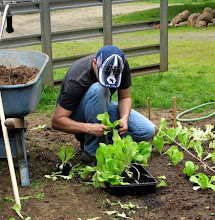What you'll need:
- Soil mix (homemade or purchased)
- Trays or plastic containers
- Seeds
- Water

Step 1: Start by assembling containers. You don't need to buy fancy planting trays: any plastic container will work. Look around the house for sour cream tubs, yogurt cups, salad domes or anything that is capable of holding soil. Make sure ALL your containers have a drainage hole cut into the bottom. Several small holes around the bottom would be better. Trust me on this...there's nothing more maddening than finding all your seeds rotted away because of a swampy tray. Most plastic is a cinch to cut with a razor blade or power drill bit.
Step 2: Fill your containers with soil mix and pack it gently. You're not trying to make bricks here...just firm it down so the seeds won't sink the bottom. Soak the soil well using tepid water and set the containers aside to drain.
Step 3: Here's the fun part. Take a deep breath, crack your knuckles and grab a long, pointed object. Bamboo skewers or pencils are especially talented. Be sure to read the back of the seed packet for the correct planting depth. Every genus is different, but in my experience 1/4 inch seems to be average. Using your pointed object of choice, create planting holes and sow 2 to 3 seeds inside of each. Recover gently with soil.
Step 4: Place a clear cover over your container. Seeds germinate best in a warm, humid environment and by covering them you are creating optimum conditions. Large ziplock bags are especially handy for pots: simply place the pot in the bag, inflate like a balloon, and seal. You'll want to open the cover for a short time each day to allow fresh air inside. Place the container in a greenhouse or in front of a sunny window and that's it! In a week or two the tray will be chock full of seedlings.

Keep in mind that direct sunlight will heat the inside of the trays, causing a greenhouse effect. Sunlight is a plant's best friend, but too much heat will kill them. Monitor the temperature or you'll end up with a tray full of pressure cooked seedlings. Which I guess isn't a total loss if you like steamed sprouts with your baked chicken dinner.








No comments:
Post a Comment